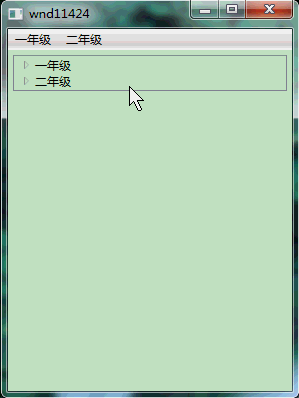WPF 模板(二)
1. DataTemplate和ControlTemplate的关系
学习过DataTemplate和ControlTemplate,你应该已经体会到,控件只是数据的行为和载体,是个抽象的概念,至于它本身长成什么样子(控件内部结构),它的数据会长成什么样子(数据显示结构)都是靠Template生成的。决定控件外观的是ControlTemplate,决定数据外观的是DataTemplate,它们正是Control类的Template和ContentTemplate两个属性值
凡是Template,最终都要作用在控件上,这个控件就是Template的目标控件,也叫模板化控件。你可能会问:DataTemplate的目标应该是数据呀,怎么会是控件呢。DataTemplate给人的感觉的确是施加在数据对象上,但施加在数据对象上生成的一组控件总得有个载体吧?这个载体一般落实在一个叫做ContentPresenter对象上。ContentPresenter类只有ContentTemplate属性、没有Template属性,这就证明了承载由DataTemplate生成的一组控件是他的专门用途。
至此我们可以看出,由ControlTemplate生成的控件树其树根就是ControlTemplate的目标控件,此模板化控件的Template属性值就是一个ControlTemplate实例。与之相仿,由DataTemplate生成的控件其树根是一个ContentPresenter控件,此模板化控件的ContentTemplate属性值就是这个DataTemplate实例。因为ContentPresenter控件是ControlTemplate控件树上的一个节点,所以DataTemplate控件树是ControlTemplate里面的一个子树。
显然,如果把数据对象赋值给ContentPresenter的DataContext属性,由DataTemplate生成的控件自然会找到这个数据对象并把它当作自己的数据源。
2. 应用
2.1 应用1
为Template设置其应用目标有两种方法,一个是逐个设置控件的Template/ContentTemplate/ItemTemlate/CellTemplate等属性,不想应用Template的控件不设置;另一种是整体应用,即把Template应用到某个类型的控件或者数据上。
把ControlTemplate应用到所有控件上需要借助Style来实现,但Style不能标记X:KEY,例如下面的代码:
<Window x:Class="WpfApplication11.wnd11421" xmlns="http://schemas.microsoft.com/winfx/2006/xaml/presentation" xmlns:x="http://schemas.microsoft.com/winfx/2006/xaml" Title="wnd11421" Height="200" Width="300"> <Window.Resources> <!--ControlTemplate作用在所有目标控件上,Style不能标记x:key--> <Style TargetType="{x:Type TextBox}"> <Setter Property="Template"> <Setter.Value> <!--使用TemplateBinding,与模版目标一致--> <ControlTemplate TargetType="{x:Type TextBox}"> <Border SnapsToDevicePixels="True" Background="{TemplateBinding Background}" BorderBrush="{TemplateBinding BorderBrush}" BorderThickness="{TemplateBinding BorderThickness}" CornerRadius="5"> <ScrollViewer SnapsToDevicePixels="{TemplateBinding SnapsToDevicePixels}"></ScrollViewer> </Border> </ControlTemplate> </Setter.Value> </Setter> <Setter Property="Margin" Value="5"></Setter> <Setter Property="BorderBrush" Value="Black"></Setter> <Setter Property="Height" Value="28"></Setter> </Style> </Window.Resources> <StackPanel> <TextBox></TextBox> <TextBox></TextBox> <TextBox Style="{x:Null}"></TextBox> </StackPanel> </Window>
Style没有X:key标记,默认为引用到所有的x:type指定的控件上,如果不想应用则将style标记为{x:null}。运行效果如下图:
2.2 应用2
把DataTemplate应用到某个数据类型上是设置DataTemplate的DataType属性,并且DataTemplate作为资源时也不能带x:key标记, 例如下面的代码:
<Window x:Class="WpfApplication11.wnd11422" xmlns="http://schemas.microsoft.com/winfx/2006/xaml/presentation" xmlns:x="http://schemas.microsoft.com/winfx/2006/xaml" xmlns:local="clr-namespace:WpfApplication11" Title="wnd11422" Height="200" Width="300"> <Window.Resources> <!--DataTemplate作用在某个数据类型上,使用DataType,不能设置x:key--> <DataTemplate DataType="{x:Type local:Unit}"> <Grid> <StackPanel Orientation="Horizontal"> <Grid> <Rectangle Fill="Red" Width="{Binding Price}" Stroke="Yellow"></Rectangle> <TextBlock Text="{Binding Year}"/> </Grid> <TextBlock Text="{Binding Price}"></TextBlock> </StackPanel> </Grid> </DataTemplate> </Window.Resources> <StackPanel> <ListBox x:Name="_listBox"></ListBox> <ComboBox x:Name="_comBox"></ComboBox> </StackPanel> </Window>
代码中的DataTemplate的目标数据类型和ListBox的条目类型都是Unit:
/// <summary> /// DataType /// </summary> public class Unit { public int Price { get; set; } public string Year { get; set; } }
指定数据源:
public partial class wnd11422 : Window { public wnd11422() { InitializeComponent(); List<Unit> _listUnit = new List<Unit>() { new Unit(){Price=100, Year="2001" }, new Unit(){Price=120, Year="2002" }, new Unit(){Price=140, Year="2003" }, new Unit(){Price=180, Year="2004" }, new Unit(){Price=150, Year="2005" }, new Unit(){Price=200, Year="2006" }, }; _listBox.ItemsSource = _listUnit; _comBox.ItemsSource = _listUnit; } }
此时DataTemplate会自动加载到所有的Unit类型对象上,尽管我没有为ListBox和CompBox指定ItemTemplate,一样会得到下图的效果:
2.3 应用3
很多时候数据是以XML形式存取的,如果把XML节点先转换为CLR数据类型再应用DataTemplate就麻烦了。DataTemplate很智能,具有直接把XML数据节点当作目标对象的功能-----XML数据中的元素名(标签名)可以作为DataType,元素的子节点和Attribute可以使用XPath来访问。下面的代码使用XmlDataProvider作为数据源(其XPath指出的必须是一组节点),请注意细节之处的变化,结果和应用2的效果相同:
<Window x:Class="WpfApplication11.wnd11423" xmlns="http://schemas.microsoft.com/winfx/2006/xaml/presentation" xmlns:x="http://schemas.microsoft.com/winfx/2006/xaml" Title="wnd11423" Height="200" Width="300"> <Window.Resources> <!--Xml中的元素名可以作为DataType--> <DataTemplate DataType="XUnit"> <Grid> <StackPanel Orientation="Horizontal"> <Grid> <Rectangle Fill="Red" Width="{Binding XPath=@Price}" Stroke="Yellow"></Rectangle> <TextBlock Text="{Binding XPath=@Year}"/> </Grid> <TextBlock Text="{Binding XPath=@Price}"></TextBlock> </StackPanel> </Grid> </DataTemplate> <!--XPath指定一组节点--> <XmlDataProvider x:Key="ds" XPath="XUnits/XUnit"> <x:XData> <XUnits xmlns=""> <XUnit Price="100" Year="2001"></XUnit> <XUnit Price="120" Year="2002"></XUnit> <XUnit Price="140" Year="2003"></XUnit> <XUnit Price="180" Year="2004"></XUnit> <XUnit Price="150" Year="2005"></XUnit> <XUnit Price="200" Year="2006"></XUnit> </XUnits> </x:XData> </XmlDataProvider> </Window.Resources> <StackPanel> <!--XmlDataProvider使用Binding--> <ListBox x:Name="_listBox" ItemsSource="{Binding Source={StaticResource ds}}"></ListBox> <ComboBox x:Name="_comBox" ItemsSource="{Binding Source={StaticResource ds}}"></ComboBox> </StackPanel> </Window>
应用4
XML的优势就是可以方便的表示带有层级的数据,比如:年级----班级----小组 或 主菜单---次菜单----三级菜单。同时WPF准备了TreeView和MenuItem控件来显示层级数据。能够帮助层级控件显示层级数据的模板是HierachicalDataTemplate。下面是实际工作中常见的例子:
值得一提的是,HierarchicalDataTemplate的作用不是MenuItem的内容而是它的Header。如果对MenuItem的单击事件进行侦听处理,我们就可以从被单击的MenuItem的Header中取出XML数据。
<Window x:Class="WpfApplication11.wnd11424" xmlns="http://schemas.microsoft.com/winfx/2006/xaml/presentation" xmlns:x="http://schemas.microsoft.com/winfx/2006/xaml" Title="wnd11424" Height="400" Width="300"> <Window.Resources> <!--年级模版--> <HierarchicalDataTemplate DataType="Grade" ItemsSource="{Binding XPath=Class}"> <TextBlock Text="{Binding XPath=@Name}"></TextBlock> </HierarchicalDataTemplate> <!--班级模版--> <HierarchicalDataTemplate DataType="Class" ItemsSource="{Binding XPath=Group}"> <RadioButton Content="{Binding XPath=@Name}"></RadioButton> </HierarchicalDataTemplate> <!--分组模版--> <HierarchicalDataTemplate DataType="Group"> <CheckBox Content="{Binding XPath=@Name}"></CheckBox> </HierarchicalDataTemplate> <!--数据模版--> <XmlDataProvider x:Key="ds" XPath="Data/Grade"> <x:XData> <Data xmlns=""> <Grade Name="一年级"> <Class Name="甲班"> <Group Name="A组"></Group> <Group Name="B组"></Group> <Group Name="C组"></Group> </Class> <Class Name="乙班"> <Group Name="A组"></Group> <Group Name="B组"></Group> <Group Name="C组"></Group> </Class> </Grade> <Grade Name="二年级"> <Class Name="丙班"> <Group Name="A组"></Group> <Group Name="B组"></Group> <Group Name="C组"></Group> </Class> <Class Name="丁班"> <Group Name="A组"></Group> <Group Name="B组"></Group> <Group Name="C组"></Group> </Class> </Grade> </Data> </x:XData> </XmlDataProvider> </Window.Resources> <!--监听事件--> <StackPanel MenuItem.Click="StackPanel_Click"> <Menu ItemsSource="{Binding Source={StaticResource ds}}"></Menu> <TreeView ItemsSource="{Binding Source={StaticResource ds}}" Margin="5"></TreeView> </StackPanel> </Window>
事件处理器:
private void StackPanel_Click(object sender, RoutedEventArgs e) { // Head为XmlElement XmlElement xmlElem = (e.OriginalSource as MenuItem).Header as XmlElement; MessageBox.Show(xmlElem.Attributes["Name"].Value); }

转自http://www.cnblogs.com/lizhenlin/p/5906678.html


 浙公网安备 33010602011771号
浙公网安备 33010602011771号